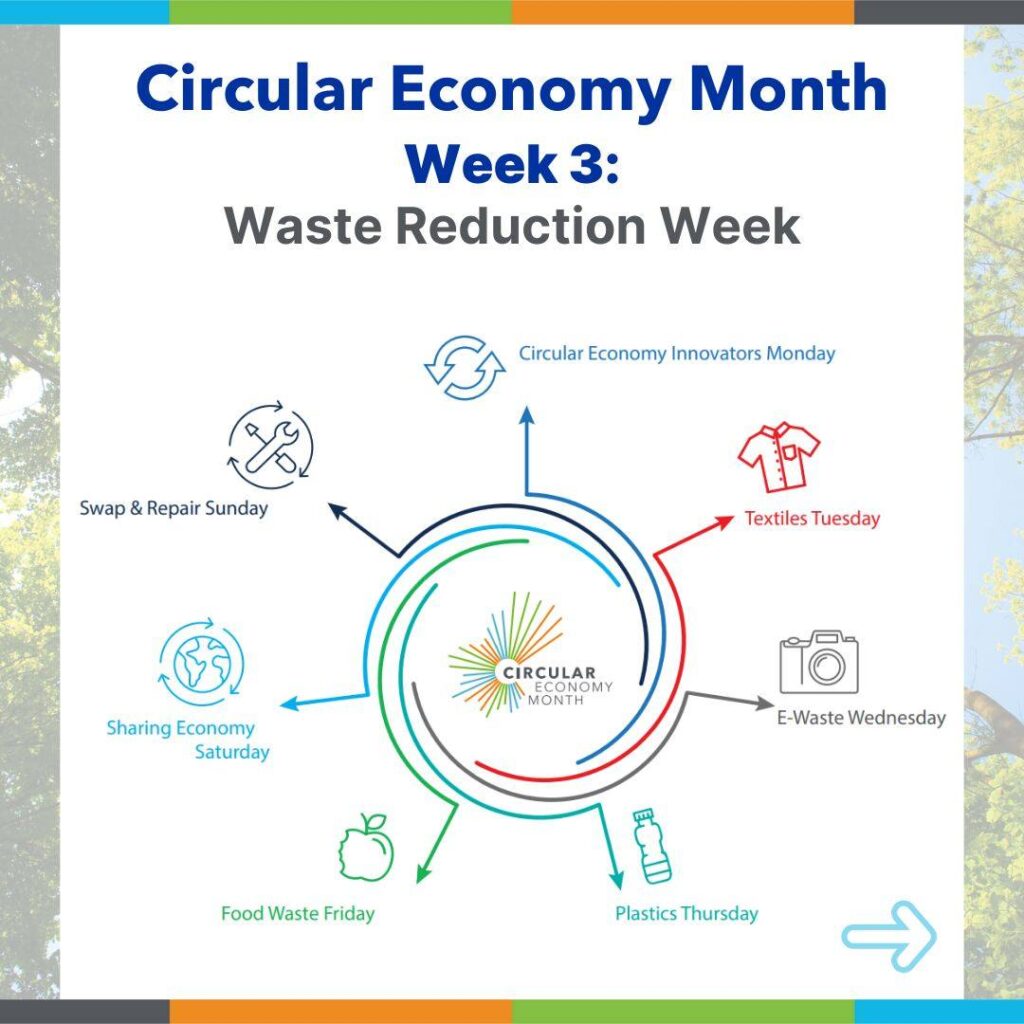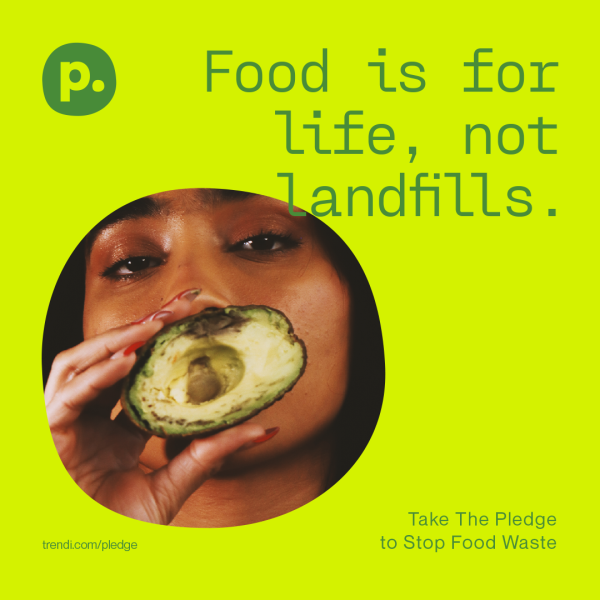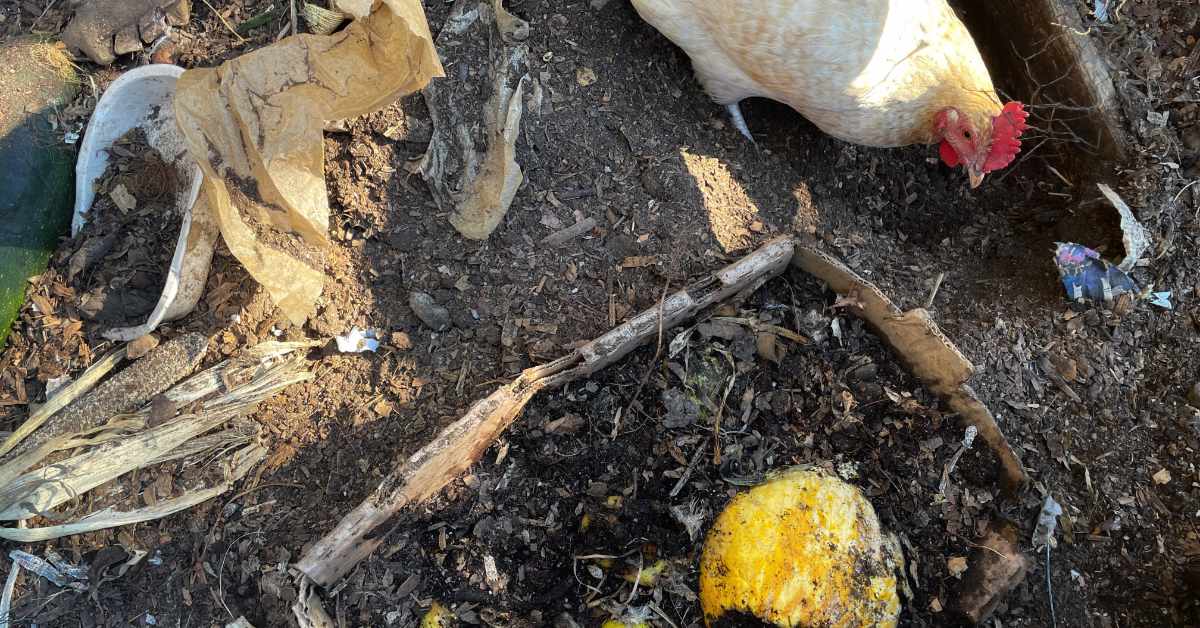Four ways to tackle wasted food on Food Waste Friday
Hello friends and readers! Welcome back to another round of Sustainability Success stories. Coincidentally (or not) it’s also Food Waste Friday, part of Canada’s annual Waste Reduction Week (which I’ve written about elsewhere on here)!
In honour of this auspicious day, I’m going to be talking about one of my favourite topics: food! But specifically, we’re going to look at wasted food….and, at ways to reduce it (because I refuse to let us wallow in misery). From individual behaviour change actions to some specific ways that tech companies are combatting the issue, it’ll be a journey. Buckle up!

What is wasted food?
As I’m learning, the problem of wasted food lies at pretty much every step of the food chain: from production right on through to retail and consumer households. Globally, we grow food on a massive scale and we waste a tremendous amount of it. Ugh. Proponents of big ag say that we need the scale in order to feed the world, and that’s probably partially true, but we certainly don’t need to be wasting as much of it as we do. Here in Canada, 13% of the food we grow never even makes it to grocery store shelves because of the impossible beauty standards we attach to our produce.
Friends, that percentage should be ZERO. OK maybe 1% – if you’ve ever successfully grown anything, you’ll know that there’s always a piece of fruit or veggie that you just don’t see, or it actually is rotten, or the chickens eat it before you do…but 13%?! Heck no! There is no excuse for wasted food, particularly at the harvesting stage. That farmers spend all of their time, money, and energy growing perfectly edible food, only to leave it in the field or throw it away, is outrageous and unconscionable. I feel so much rage when I think about this.
Phewwwww…
Circular food systems – a workshop
Last year, I sat in on a few workshops hosted by Canada’s National Zero Waste Council, all about this very topic. The first was titled “Scaling Circular Food Systems in Canada” and the primary objective was to look at what it will take to transition Canada’s food systems from linear to circular, by identifying linkages with social equity, climate, tech, and business. The second (and my favourite) was “Behaviour Change Strategies for Circular Food Solutions.”
OK so straight off the bat, I firmly feel that much of the onus for this problem should be on corporations, industry, and big business to change their ways of doing business. They have totally capitalized on our behaviours in order to further their corporate interests and they’ve gotten us into this mess (it’s been proven, I will fight you on this, so let’s just move on!). AND. I love behaviour change strategies because they’re a huge part of what will be needed to get us out of the hole we’ve so deeply dug.
Word choice!
One of the big takeaways from these workshops, for me, was that words matter when it comes to talking about food waste, or rather, wasted food. They are different! We say “food waste” a lot, and you’ll hear/read/see that in the general media landscape, but what we really mean, most of the time, is “wasted food.” These seem like subtle differences on the surface, but they are a big deal (in the same way that placing plastic bottles in popular TV and movies is a subtle way of OK-ing its consumption…). Certainly, there are cases of food actually going to waste: rotten, or damaged to the point of no return, that kind of thing. But in most cases, we are really talking about perfectly good food that is wasted: misfit produce, produce that is a little tired but still edible, processed foods that are still safe to eat despite expired sell-by dates, cooked food from buffets and restaurants because they made too much. You get the picture.
“Calling it “food waste” is enabling a perception that unsold or inedible food is worthless.”
– Ryan Begin, CEO and co-founder of Divert, Inc,. via Forbes
Shifting blame
Misrepresenting wasted food also puts the onus on the consumer and we have enough problems without feeling guilty all the damn time. I know, I know, I just said that behaviour change is my favourite thing, and it is! And, yes, of course, some wasted food is a result of our crappy cooking and shopping habits. I think we can all safely agree that there has been a time in each of our lives when we’ve ambitiously bought a cartful of veggies, only to find them languishing in the back of the veggie drawer weeks later, a science experiment about to walk out the door.
So while it’s important to pay attention to how we shop, cook, and eat (which we’ll get to later!), it’s also really important that we recognize that the vast majority of wasted food happens before we even see it or realize it’s happening (i.e. at the retail or farm-gate level)
Motivations and a sense of agency
As consumers, we also have different motivations around food, and that can lead to gaps between what we say or do about it. And, we’re living in a big, big world which can feel out of control most of the time. (Sorry, my apologies: this world is out of control). It’s hard to take action when you feel like you have no agency. The speakers in both of the aforementioned workshops talked about the need to strive for self-efficacy and I could not agree more. If we don’t feel like we can tackle this thing, we won’t. I’m sure anyone who has had a mountain of work staring them in the face can understand this! (Me. This is me.)
“There are behavioural and psychological barriers that prevent us from acting in accordance with our values”
– NZWC webinar, Behaviour Change Strategies for Circular Food Solutions
Across both workshops, several solutions were suggested for tackling this global issue. One point that was repeatedly mentioned in these conversations, in addition to behaviour change and building a sense of agency, was the urgent need to retool our current food infrastructure. We need to allow for more upcycling and other methods of food diversion.
This is when I learned about Trendi Tech.
Let’s dip our toes into the tech world, shall we?
But first, a backstory…
Back in 2018, I had a random encounter at a refillery in the cute lil mountain town of Kimberley, BC. Jan and I were making our way back from a work project in the Kootenays (a beautiful part of eastern BC) and stopped in. I’m a sucker for a cute, small town and Kimberley totally fits the bill. Charming, downtown walkable street that reminded me of Church Street in Burlington, Vermont. Cute shops with an emphasis on small, independent businesses. A chain gas station that appeared like a normal gas station from the outside but inside, had been transformed into a beautiful grocery store FULL of fresh produce and organic goods, including my faveeeee juice, Stoke!
There was also a zero-waste refillery, Fulfill Zero Waste Market, which obviously, I had to check out! I can’t even remember now what we picked up there but what I do remember is chatting with Elysia, one of their employees. I can’t remember what we talked about (probably how awesome refilling is!) but by the end, we were exchanging Instagram handles (as one does in the 21st century) and we stayed in touch.
Then, years later, she sent me a note telling me about a tech company she was working for at the time and that I might be interested in it because it was all about tackling food waste! Enter…Trendi Tech, a Vancouver-based tech startup tackling food waste (I mean, wasted food!). Say what?!
Side note
I love connecting multiple, seemingly disparate issues together (everything is always connected, we should know this by now). And, more and more, it’s being made clear that all issues require multiple, different, solutions. As humans, we so desperately want quick fixes and silver bullets, but the reality of life on this planet is that everything is complicated, nuanced, and lives in the gray zone of several solutions happening all at once. MESSY.
Food and plastic and waste are two issues that don’t always seem related but intrinsically are, and I get really fired up about them. We grow food and ship it all over the world, and we wrap it in plastic so it makes it to its destinations without spoiling (win for food waste). We slap plastic stickers on everything (terrible for compost). We also over-wrap things that don’t need wrapping (hello, bananas, mangoes, potatoes! why!). In some cases, plastic actually does help us reduce food waste in our globalized societies. But, it’s complicated (see above, living in the gray zone).
OK, so…where’s the tech?
To be honest, anything with the word tech in it these days makes me a little apprehensive, but after glancing at Trendi’s posts that Elsyia shared with me, I got into the way they were marketing themselves. Which is to say, it felt “soft.” All of their posts on IG were about how much food we as Canadians waste and what everyday people can do about it. They seemed to have some tech solutions for large-scale food producers, but it wasn’t overt and mostly, it seemed like they just wanted to educate people about how to stop wasting so much food (and also, how to preserve food before it was landfilled).

By now, you know that I love to talk to the people behind the “thing” and figure out what fired them up so much about it to make them want to start a tech company (for example)! On the cusp of a global pandemic, no less!
Chatting with Carissa, Trendi Tech’s co-founder, was like chatting with a firecracker. She is punchy, hilarious, and honest. She told me how she and her husband Craig started Trendi in August 2019, and that part of their motivation was that they themselves had experienced food insecurity. To them, it really hit home just how much perfectly good food was collectively being tossed, all while many people (like them) didn’t have enough to eat. They wanted to try to help right that wrong.
So, mere months before our world shut down due to the COVID-19 pandemic, they incorporated Trendi Tech. The goals were simple, yet ambitious: save misfit produce from being wasted at the farm gate, turn it into a nutritionally dense, shelf-stable product, and help increase access to healthy food for all. Also, educate the masses about the issue of food waste to compel behaviour change. Woo!
The people behind the tech
As you’ve no doubt learned if you hang around here long enough, I love to find human stories behind the issues I’m passionate about. In the past, we’ve talked about nature in media through the eyes of John at SEA-Media, or how the High-End Hippie’s shampoo bars make people accidental environmentalists.
Wasted food is no different!
One of the reasons Carissa and Craig are so passionate about food waste is that they have personally experienced food insecurity. At one point in the recent past, they were living on $1.50/day. At that point, they realized how precarious that situation actually is, and how absurd. In a world of abundance, how is it possible that humans are going hungry, living below the poverty line, or having to make serious decisions about whether to eat or pay the bills?
This question came up for Carissa and Craig, too. They really wanted to find a way to bridge the gap between food producers, consumers, and all that wasted food. Carissa recalls, “I think the solution came first because we were seeking a more fair system.”
This, it turned out, had been an issue on Carissa’s mind for some time, before she experienced food insecurity herself. She says her ‘aha’ moment about the idea of food waste actually came years earlier while working with a juice company in Vancouver and realizing that the produce they were procuring for their juice didn’t have to be pretty. It was going to get juiced anyway!. They could purchase misfit “stage 2 or 3” produce straight from the farm and minor blemishes or other knicks wouldn’t matter. Through this, they rescued 40,000 pounds of food and were able to reduce their costs by 40%, the cost savings of which were passed on to consumers. Less wasted food + money saved for both business and customers = win, win, win!
Trendi Tech and the farm-gate solution
Fast forward and now Carissa’s brain wheels started spinning: if it worked for juice, what else could it work for? This was the seed that started Trendi Tech. Working together, Cariss and Craig merged their passions for food and cooking (Craig is a professional chef), their curiosity around biotech, and their desire to save misfit food from being wasted. They mashed it all up into one prototype product and called it “biotrim.” This is where the “tech” part of their business kicked in. Their solution captured the freshness and nutrient value of produce straight from the farm (the “farm gate”) and turned it into shelf-stable products via a mobile processing unit housed in a shipping container! The resulting product could be used by food processors, other farms, or even by everyday eaters like you and me. It’s just one method of getting perfectly good food out of the landfill and into the hands of eaters who need good food. In 2020, they raised $2.5M in seed funding for their startup and what began as two employees quickly grew to 80 in just six months. Super cool.
Trendi isn’t the only company to try tackling wasted food at this level of production. A quick Google search reveals that there are tech startups across Canada (and beyond) working to capture food and preserve it for other uses (uses that involve it being eaten, by humans!).
Carissa and Craig have now (as of March 2023) handed over the reins of their company to a new CEO, but they’ll continue to sit on the board and advocate for Trendi’s solutions at events on the world stage.
Of course, we know that we shouldn’t put all our eggs in one basket and so, we need to be looking at other ideas, too. This whole thing is messy and there are no quick fixes (and it’s an all-hands-on-deck situation). Fundamentally, we need to eat more of the food we produce (or be allowed to eat it!) and what we purchase and bring home. Back to the consumer level, we go!
Power to the people: bring back reverence for food
At one point during our conversation, Carissa told me about her grandparents. They lived in wartime Italy and, like many at that time, they didn’t have much. When food was scarce, they felt it. But at the same time, there was a deep sense of reverence for food and for community. They helped their neighbours and shared resources when it was needed. Nowadays, she says, “We lost our appreciation for food somewhere in the mix. If we can start appreciating and valuing our food for what it is, it’ll really help over a long, long time.”
She’s so right. With our gluttonous abundance has come a loss of reverence for our food. We don’t see our farmers anymore, we rarely see the animals we consume, and we have little way of knowing exactly where our food came from. Step one in tackling wasted food is that we have to appreciate our food more. This requires slowing down, being intentional and considerate of purchasing and cooking.
One of the things Carissa suggested, when I asked her for some ways we as individuals can tackle wasted food, was to make fridge soup! She also talked about changing the way we buy groceries, which I am sure you all have opinions about. I grew up going to the grocery store once every two weeks because we lived 30 miles from the big grocery store. We had to stock up! Carissa’s suggestion kind of goes against everything I was raised with: instead of shopping for weeks at a time, what if we bought food just one week ahead? And what if we avoided Costco?! That way, as Carissa pointed out, you’d “Buy what you need, use it up and then buy it again.”
But, of course, there are tradeoffs here. Live in a rural area, like my parents? You’re trading fresh groceries for higher carbon emissions from driving more frequently to the grocery store. Like I said; this sh*t is messy, complicated, and there are no easy answers! What we can all agree on, though, is that we should eat what we buy.
“It’s all about just having an appreciation for your food. “We lost our appreciation for food somewhere in the mix. If we can start appreciating and valuing our food for what it is, it’ll really help over a long, long time.”
SHIFT into a new way of thinking about food
Back at the Behaviour Change Strategies for Circular Food Solutions workshop, speakers and participants were effervescing about different methods for getting people – and businesses – to change the course on wasted food. Angela Cooper at BEWorks, shared an acronym from a 2018 study by Sitra, that hit me like a ton of bricks: S.H.I.F.T. Yes!
Social Influence
Habit Formation
Individual Self
Feelings and Cognition
Tangibility
Here are my notes:
- Social influence: this is where we do things to encourage our social networks to do the thing we want them to do. Maybe we suggest, “Friends on campus are composting, too” or we take pledges. (For a time, Trendi was running a 21-day food waste reduction pledge campaign.)
- Habit Formation: oh, those damn habits. How many books do I have about making/breaking habits? Don’t ask. The key is to disrupt the bad habit and make it easy to establish a new one. One thing that works really well is to create “defaults” – make the desired action the default. If you default lunch choices to vegetarian but give people the option to ask for a non-vegetarian meal, 87% of people choose the “default” veggie meal. Crazy, right?
- Individual Self: this is where we appeal to personal values – what’s driving us to do anything? Is it about civic duty, bolstering community, saving moola? How do we help people see that they have an individual impact that can ripple out?
- Feelings & Cognition: this is, for me, the heart of the matter. In order to rethink, we first have to reframe the issue and we have to feel into it. Instead of describing the negative impact, what if we focused on “gain” framing, or the positives? We also need to really consider the emotions around food and systems change because they are deeeeep. But, we know that coming down with a hammer will make people retreat or veer towards apathy, so where’s the balance that leads people to feel a sense of agency?
- Tangibility: raise your hand if you’ve ever felt like climate change and “sustainability” are big, puffy, abstract, and vague “things out there.” Me, too. It has to feel real and tangible for us to even get out of bed to try. More and more, we’re seeing infographics depicting how much water is used to make one burger or things like Surfrider’s plastic sushi campaign to raise awareness about plastics in the ocean. We are visual creatures, show us the money!
Lest you think this is just a bunch of airy-fairy nonsense, there are case studies (nerd alert!). You can read the full report from Sitra here.
Wasted food makes it to prime time
The awareness around this issue is growing, which is eggcellent news.
I can’t even believe I’m saying this here, or linking to the YouTube video, but even Hellman’s got on board with its recent Superbowl spot. (Super important note: Hellman’s is in no way affiliated with this post, and I am begrudgingly sharing their ad.) I missed seeing it live, but Carissa mentioned it to me during our conversation and it came up in one of the workshops, so I figured I should probably mention it. Ok, ok, FINE…it is pretty funny.
And as more and more people are feeling the very real squeeze of financial and food insecurity these days – all with the increased awareness that we are producing/wasting too much – we urgently need to get a handle on this beast.
Tackling wasted food, on all the levels
We all need a place to put our energy these days and work on something concrete. Here’s a summary of what you can do about wasted food:
- For starters, eat what you buy! Make fridge soup. Or be OK with random meals. (The other day I made tacos with leftover oatmeal and steamed beets. Was it weird? Yes! Did it taste good? Yes! Will I make it again? Probably not, but it got me to eat my leftovers!)
- Need a kick? Take a pledge to not waste food, get an accountability buddy, cook with friends, or try new recipes.
- Skip the grocery store and go straight to the farm (if it’s a possibility for you). Chances are it will be fresher, cheaper, and more fun.
- Spread those ripples and be an advocate. Talk to your favourite grocery store manager, write them a letter and tell them you don’t need perfect produce! Then, copy/paste that letter and send it to your elected representatives to make it clear to them that this is an issue they need to be focused on. Talk to your farmer’s market, mayor, and food bank about ways you can help ensure equitable access to fresh food.
Sometimes, wasted food happens, but it should be a rare exception and not an inevitability. We should not be wasting as much of it as we do, particularly given that we are 8-some-odd billion people on this planet and that everyone deserves to eat.
I’d love to hear from you how you reduce wasted food in your own kitchen, or if you’ve campaigned in your communities for better access to food! Let me know in the comments. 🙂








This was soooo great!! Inspiring and informative! Thank you for always challenging me to think and do better 🙂 Might be time to plan our next dinner together, but first, let’s take stalk of what’s in our fridges 🙂